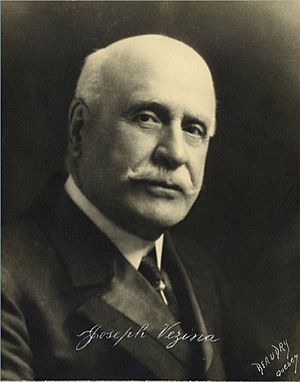Joseph Vézina facts for kids
François-Joseph Vézina was a very important musician from Quebec City, Canada. He was born on June 11, 1849, and passed away on October 5, 1924. Vézina was a talented conductor, a composer who wrote music, an organist, and a music teacher. He is buried in the Cimetière Notre-Dame-de-Belmont in Sainte-Foy.
Contents
Vézina's Early Life and Music Journey
François-Joseph Vézina was born in 1849. His father, François Vézina, was a house painter who also loved music. He taught young Joseph how to play the piano. Vézina also had a short time studying with Calixa Lavallée, another famous musician. But mostly, Vézina learned music by himself.
His Amazing Music Career
Vézina's music career started in military bands. In 1867, he joined a group called the Voltigeurs de Québec. He played the baritone horn in their band. A year later, in 1868, he became the bandmaster (the leader of the band) and stayed in that role until 1879.
Vézina later created and led many different music groups. These included military bands, amateur groups, and professional orchestras. One of his most famous groups was the Orchestre Symphonique de Québec, which he led from 1902 until he passed away.
Leading "O Canada" for the First Time
A very special moment in Vézina's career happened on June 24, 1880. He was the conductor for the very first performance of a song called O Canada. This song later became Canada's national anthem!
Vézina as a Composer
Vézina was also a skilled composer. He wrote three opéra comique, which are like funny operas.
- Le Lauréat (1906)
- Le Rajah (1910)
- Le Fétiche (1912)
He was working on a fourth opera, La Grosse Gerbe, but he passed away before he could finish it.
Teacher and Cultural Leader
Throughout his life, Vézina was a central figure in the music and culture of Quebec City. He was a teacher, a musician, a conductor, and a composer. He also worked hard to support music and art.
In 1922, he helped start the music school at Laval University. He taught there until he died. Some of his well-known students included Henri Gagnon and Robert Talbot.


